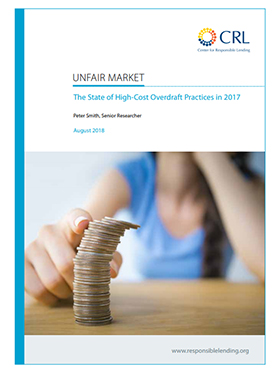According to new data released recently by the FDIC, the largest banks in America collected $11.45 billion in overdraft and non-sufficient funds (NSF) fees from American consumers in 2017, an increase of approximately $10 million over the 2016 total. Overdraft fees often impose a great burden on those already living paycheck to paycheck, struggling to make ends meet. Typically, a small proportion of bank account holders pay a large proportion of total overdraft fees. Since 2015, the FDIC has collected and released information about these controversial penalty fees from banks that have $1 billion or more in assets. Therefore, $11.45 billion does not represent the total overdraft fees collected, because it does not include those collected by small banks or credit unions, institutions which are not required to report their fee volume to the FDIC.
Financial institutions typically charge an overdraft fee when a customer’s account lacks sufficient funds to cover a transaction, but the institution chooses to pay the transaction anyway. Overdraft fees can be triggered by debit card point-of-sale (POS) transactions, ATM withdrawals, electronic bill payments, and paper checks. Some institutions do not charge overdraft fees on POS or ATM withdrawals—simply declining the transaction at no cost when the account lacks sufficient funds—but many banks do. The bank typically charges a fee, averaging $35 for each individual overdraft transaction it pays,1 even when the customer overdrafts by a very small amount. In addition to the high fee, the institution repays itself for the overdrafted transaction directly from the customer’s next deposit, in effect “jumping the line” ahead of any other planned transactions or debts the consumer has. If time lags before the account is replenished, the institution may charge additional sustained/extended overdraft fees even in the absence of further overdrafts.
This report analyzes the overdraft income of banks with assets of $1 billion or more and reviews the overdraft practices of the 10 largest banks in the US, shining light upon the rules and procedures they each employ.
The analysis found that:
- Large banks reported charging consumers $11.45 billion in overdraft and NSF fee revenue in 2017, up $10 million from the 2016 total and up 2% from 2015. Nine billion dollars of this amount was earned by the 20 banks that charged the highest volume of fees.
- All 10 of the nation’s largest banks charge overdraft fees in excess of $30, although a few do not charge these fees on POS and/or ATM transactions;
- More than one of the top 10 largest banks still engage in each of the following abusive practices: charging sustained/extended overdraft fees in addition to per-transaction overdraft fees; using high-to-low transaction processing for some types of debit transactions; and allowing five or more overdraft fees to be charged per day to customers.
